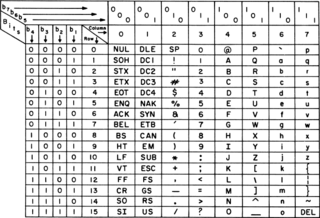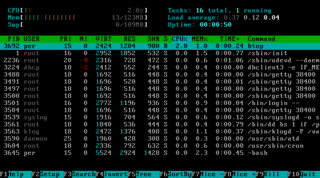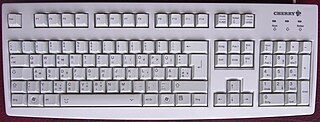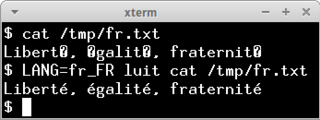
ASCII, abbreviated from American Standard Code for Information Interchange, is a character encoding standard for electronic communication. ASCII codes represent text in computers, telecommunications equipment, and other devices. Most modern character-encoding schemes are based on ASCII, although they support many additional characters.
In computing and telecommunication, a control character or non-printing character (NPC) is a code point in a character set, that does not represent a written symbol. They are used as in-band signaling to cause effects other than the addition of a symbol to the text. All other characters are mainly printing, printable, or graphic characters, except perhaps for the "space" character.
In computing and telecommunication, an escape character is a character that invokes an alternative interpretation on the following characters in a character sequence. An escape character is a particular case of metacharacters. Generally, the judgement of whether something is an escape character or not depends on the context.
An escape sequence is a combination of characters that has a meaning other than the literal characters contained therein; it is marked by one or more preceding characters.

ANSI escape sequences are a standard for in-band signaling to control cursor location, color, font styling, and other options on video text terminals and terminal emulators. Certain sequences of bytes, most starting with an ASCII escape character and a bracket character, are embedded into text. The terminal interprets these sequences as commands, rather than text to display verbatim.

Newline is a control character or sequence of control characters in a character encoding specification that is used to signify the end of a line of text and the start of a new one. Some text editors set this special character when pressing the ↵ Enter key.

A computer terminal is an electronic or electromechanical hardware device that can be used for entering data into, and transcribing data from, a computer or a computing system. The teletype was an example of an early day hardcopy terminal, and predated the use of a computer screen by decades.
The null character is a control character with the value zero. It is present in many character sets, including those defined by the Baudot and ITA2 codes, ISO/IEC 646, the C0 control code, the Universal Coded Character Set, and EBCDIC. It is available in nearly all mainstream programming languages. It is often abbreviated as NUL. In 8-bit codes, it is known as a null byte.
ISO/IEC 2022Information technology—Character code structure and extension techniques, is an ISO standard specifying:

In computing, text-based user interfaces (TUI), is a retronym describing a type of user interface (UI) common as an early form of human–computer interaction, before the advent of graphical user interfaces (GUIs). Like GUIs, they may use the entire screen area and accept mouse and other inputs. They may also use color and often structure the display using special graphical characters such as ┌ and ╣, referred to in Unicode as the "box drawing" set. The modern context of use is usually a terminal emulator.
ANSI.SYS is a device driver in the DOS family of operating systems that provides extra console functions through ANSI escape sequences. It is partially based upon a subset of the text terminal control standard proposed by the ANSI X3L2 Technical Committee on Codes and Character Sets.

Box-drawing characters, also known as line-drawing characters, are a form of semigraphics widely used in text user interfaces to draw various geometric frames and boxes. Box-drawing characters typically only work well with monospaced fonts. In graphical user interfaces, these characters are much less useful as it is more simple and appropriate to draw lines and rectangles directly with graphical APIs. However, they are still useful for command-line interfaces and plaintext comments within source code.

On computer keyboards, the Esc keyEsc is a key used to generate the escape character. The escape character, when sent from the keyboard to a computer, often is interpreted by software as "stop", and when sent from the computer to an external device marks the beginning of an escape sequence to specify operating modes or characteristics generally.
The C0 and C1 control code or control character sets define control codes for use in text by computer systems that use ASCII and derivatives of ASCII. The codes represent additional information about the text, such as the position of a cursor, an instruction to start a new line, or a message that the text has been received.

Sixel, short for "six pixels", is a bitmap graphics format supported by terminals and printers from DEC. It consists of a pattern six pixels high and one wide, resulting in 64 possible patterns. Each possible pattern is assigned an ASCII character, making the sixels easy to transmit on 7-bit serial links.
The delete control character is the last character in the ASCII repertoire, with the code 127. It is supposed to do nothing and was designed to erase incorrect characters on paper tape. It is denoted as ^? in caret notation and is U+007F in Unicode.

The Linux console is a system console internal to the Linux kernel. The Linux console provides a way for the kernel and other processes to send text output to the user, and to receive text input from the user. The user typically enters text with a computer keyboard and reads the output text on a computer monitor. The Linux kernel supports virtual consoles – consoles that are logically separate, but which access the same physical keyboard and display. The Linux console are implemented by the VT subsystem of the Linux kernel, and do not rely on any user space software. This is in contrast to a terminal emulator, which is a user space process that emulates a terminal, and is typically used in a graphical display environment.
In computing and telecommunications, the capabilities of a terminal are various terminal features, above and beyond what is available from a pure teletypewriter, that host systems can make use of. They are (mainly) of control codes and escape codes that can be sent to or received from the terminal. The escape codes sent to the terminal perform various functions that a CRT terminal is capable of, but that a teletypewriter is not; such as moving the terminal's cursor to positions on the screen, clearing and scrolling all or parts of the screen, turning on and off attached printer devices, programming programmable function keys, changing display colours and attributes, and setting display title strings. The escape codes received from the terminal signify things such as function key, arrow key, and other special key keystrokes.

luit is a utility program used to translate the character set of a computer program so that its output can be displayed correctly on a terminal emulator that uses a different character set. Whereas iconv converts the character set of strings or text files at rest, luit converts the input and output of programs running interactively.

DEC Special Graphics is a 7-bit character set developed by Digital Equipment Corporation. This was used very often to draw boxes on the VT100 video terminal and the many emulators, and used by bulletin board software. The designation escape sequence ESC ( 0 switched the codes for lower-case ASCII letters to draw this set, and the sequence ESC ( B switched back. IBM calls it Code page 1090.










